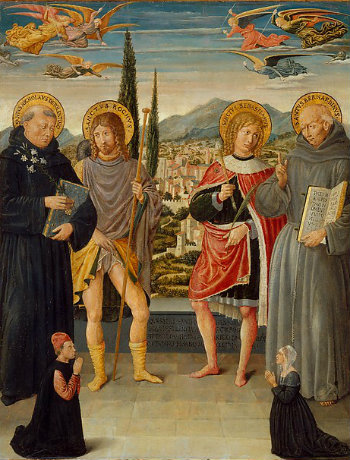Search:: Artists Alphabetically Artists by Country Artists by Century Artists by Movement
Benozzo Gozzoli
1420-1497
Florentine Painter of the Early Renaissance
Stylistically influenced by the following painters - Masaccio, Sassetta, Fra Angelico
Education - apprenticed to Fra Angelico
Cause of Death - old age

One of the Greatest Painters Of All Time
Biography
Information and Facts About the Artist
About the Artist
Benozzo Gozzoli was born in Italy in 1449. His people were impoverished tailors and cobblers. Young Benozzo had to fight for every crust of bread in his early life. Gozzoli's greatness derived from his ability to depict pious religious themes while retaining an expressive warmth in his art. He lived and worked in Florence most of his life and thus was influenced by Florentine painters. John C. Van Dyke, author and art historian, commented "The Florentines were draughtsmen more than colorists. The chief medium was fresco on the walls of buildings, and architectural necessities often dictated the form of compositions. Distemper in easel pictures was likewise used, and oil-painting, though known, was not extensively employed until the last quarter of the century. In technical knowledge and intellectual grasp Florence was at this time the leader and drew to her many artists from neighboring schools."
Gozzoli appeared to make a conscious effort in creating artworks that appealed to the uneducated peasant class as well as the clergy. Regardless of class, his layers of meaning are captivating. Gozzoli's paintings are overflowing with rich biblical symbolism and at the same time invite the viewer to uncover their own meaning and connection to the artwork. The ruling Church hierarchy and affluent merchants adored his sweet, lyrical style and the commissions rolled in. He was also awarded land and villas by the state. Gozzoli's shrewd business practices allowed him to live high on the hog until his death at the age of 77 . He is one the greatest Early Renaissance painters of all time.
Benozzo
Gozzolie was a portrait painter as well as painting religious subjects.
Some of his greatest masterpieces depict the lives of saints. Clive Bell, author and art historian asserts
"The emotional renaissance in Europe was not the wide-spreading of
Christian doctrines, but it was through Christian doctrine that Europe
came to know of the rediscovery of the emotional significance of the
Universe. Christian art is not an expression of specific Christian
emotions; but it was only when men had been roused by Christianity that
they began to feel the emotions that express themselves in form. It was
Christianity that put Europe into that state of emotional turmoil from
which sprang Christian art."
Foundations of the Renaissance
The endless curiosity of Renaissance painters for all things classical spurned them on to study the human body in ways not seen since the ancients. A change of attitude was taking place. Artists reveled in their new found passion, the passion for beauty, for sophistication, and for elegance.
At the closing of the fourteenth century there was an awakening of the senses. Italy felt the awakening earlier than the rest of Europe, and felt it far more powerfully. Its first manifestation was a limitless and unquenchable curiosity, urging people to find out all they could about the world and about man. They looked around them at the amazing building that still stood, the Roman forum, the coliseum and realized that something truly great had preceded them. People turned enthusiastically to the study of classic literature and ancient civilizations. They were inspired by the vast store-house of long forgotten knowledge of antiquity. Walter Pater observed "No account of the Renaissance can be complete without some notice of the attempt made by certain Italian scholars of the fifteenth century to reconcile Christianity with the religion of ancient Greece. "
The newly emerging painting techniques and styles were a reflection of the transformation that was taking place in Europe, the change from the medieval period to a more enlightened, tolerant society. Artists, writers and scholars were flourishing. Great states were being created. Large centers of commerce were being founded. High above the turreted towers of the castle and the peaked roof of the town-hall, rose the slender spire of the newly built Gothic cathedral. Everywhere the world was in transition. The newly wealthy merchat class, was becoming conscious of their own strength and were struggling to throw off the yoke of their feudal masters.
Key Descriptive Words and Phrases associated with the Renaissance Movement - rebirth, rediscovery of the classical world, City-state, Humanism, Humanist, Francesco Petrarch, Reform, The Prince, Theocracy, The Inquisition, Human Reasoning, publication of Della Pittura, a book about the laws of mathematical perspective for artists, sfumato, chiaroscuro, linear perspective, Heliocentric Theory, vanishing point, Savonarola, spiritually significant, illuminated manuscript, idealized biblical themes, scriptorium, emotion, illuminator, Age of Discovery, axonometric drawing, curiosity about the natural world, mythology, realistic use of colours and light, Bonfire of the Vanities, Old Testament stories, ethereal and foggy backgrounds, Gospel parables, The Blackdeath, romanticized landscapes, Christian symbolism. Paradise
☼☼☼☼☼
Require more facts and information about the painter and the artists of the renaissance era? Poke around every nook and cranny of the known universe for information this subject. Search Here
© HistoryofPainters.com If you like this page and wish to share it, you are welcome to link to it, with our thanks.